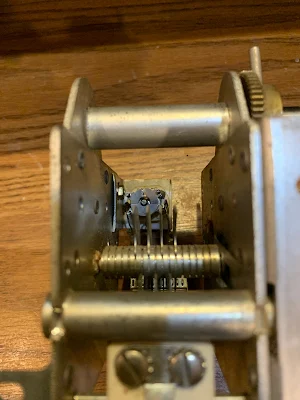Heroic stuff. In more ways than one. FB Mark.
Podcasting since 2005! Listen to Latest SolderSmoke
Friday, February 18, 2022
Thursday, February 17, 2022
How The Physics of Resonance Shapes Quantum Reality
Here is an interesting article that appeared in Wired. It will resonate with many SolderSmoke listeners!
Tuesday, February 15, 2022
Differential Temperature Compensation Capacitors in the Hallicrafters HT-37 Main VFO Tuning Circuit
Monday, February 14, 2022
Podcast (Audio) Version of Bill's Talk to the L'Anse Creuse Amateur Radio Club
Tony G4WIF suggested that I make this talk available as an audio recording. Good idea. Here it is:
http://soldersmoke.com/N2CQRHomebrewing.mp3
6EA8s in the Mate for the Mighty Midget, and WA9WFA Re-Builds a Heath HW-12
I reported to Scott and Grayson that I had finally gotten around to changing the three aging 6U8 tubes in my Mate for the Mighty Midget receiver. I replaced them with three more youthful 6EA8s. This switch really seemed to perk up the old receiver. I'm listening to 75 meters on it right now.
Speaking of 75 meters, Scott sent me this picture of his latest effort: re-building a Heathkit HW-12. FB. This is a way of experiencing (or re-experiencing) the construction of a Heathkit. I did something similar, but much less complicated) with a Heathkit VF-1. Scott did a wonderful job taking this old rig apart. That PC board looks great (see photo below).
Scott's e-mail:
Hi Bill and Grayson, I’m glad to hear of your good results with the 6EA8’s in your MMMrx! I had similar results when I finally got rid of the 6U8’s with their iffy performance and went with the 6EA8’s. I did put a set of 6GH8A’s and tried it out, it worked, but I don’t have any data on performance improvements. After completing the outboard power supply and audio amplifier, I’ve taken a break from my MMMRx and it’s sitting there on the bench. I’ll get back to it in a while.
In the meantime I’ve started a new project where I’m re-kitting a Heathkit HW-12 eighty meter transceiver. I have completed the disassembly process including the pcb. I bought a Hakko vacuum desoldering iron for taking all (ALL) parts off of the pcb, and it’s bare now. I’m planning to start rebuilding this coming week. 73 Scott WA9WFA
Friday, February 11, 2022
Bill Talking about Homebrew Radio with L’Anse Creuse Amateur Radio Club (Michigan) -- February 2, 2022 (Video)
Wednesday, February 9, 2022
Video of SolderSmoke Podcast #235
One contact on uBITX. More SW listening.
Repaired my Chrome Book in Santo Domingo!
Christmas Present for All: James Web Space Telescope launch
Monday, February 7, 2022
SolderSmoke Podcast #235 NE-602, Azores Rig, Spur Problems, SSB Rigs, Peashooter, HB Filters, MAILBAG
SolderSmoke Podcast #235 is available for download:
One contact on uBITX. More SW listening.
Repaired my Chrome Book in Santo Domingo!
Christmas Present for All: James Web Space Telescope launch
Sunday, February 6, 2022
FLASHBACK: The Herring Aid 5 Direct Conversion Receiver and Frank Jones (Video)
Saturday, February 5, 2022
Thomas K4SWL -- SOTA Activation on Bearwallow Mountain, North Carolina (video)
Friday, February 4, 2022
Barefoot Ham Radio -- PA2OHH's Wonderful Web Site
Barefoot technology or simple, non-professional radio technology and real Barefoot power or harmless QRP power, that is what you will find here. There are some complex designs but many designs are simple radio amateur circuits. They will never be used professionally!
These simple circuits and rigs can give you much fun: home brewing, portable activities during holidays, etc.
Batteries and inverted V dipole antenna's with a fishing rod as the center support are all you need to make many QSO's.
Much fun!
Barefoot technology and Barefoot power can give you much fun, but is not perfect... There are disadvantages like VXO control instead of a VFO, direct conversion receivers that receive both sidebands and simple frequency displays that are not so easy to read. But working with such simple equipment is often more exciting than working with a much better commercial transceiver.
Perhaps that you cannot believe that you can make many QSO's with QRP power of only 1 watt. Indeed, some practice is needed in the beginning so do not give up too soon. Every boring standard QSO becomes an exciting experience with QRP power!
--------------
Check out Onno's site: https://www.qsl.net/pa2ohh/











































